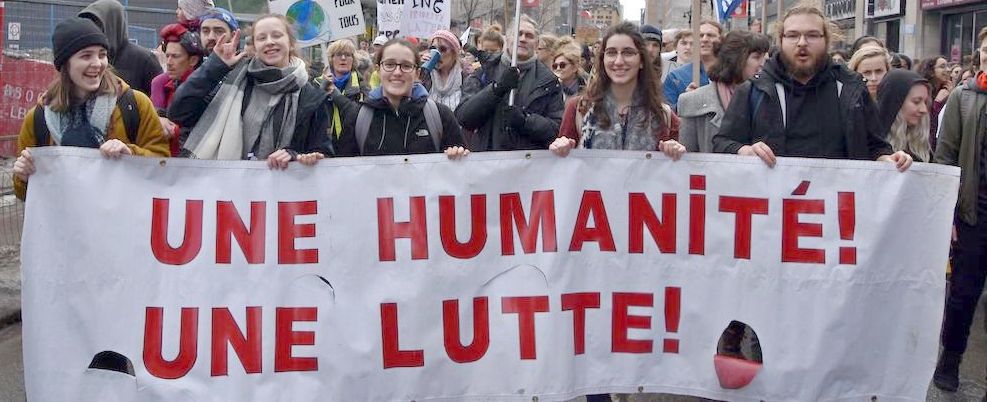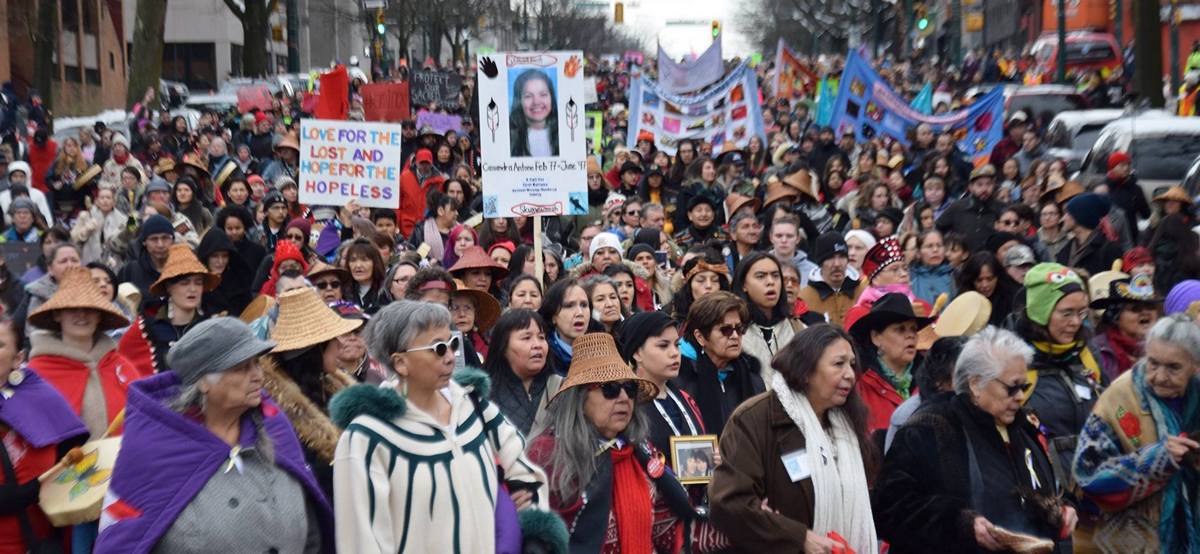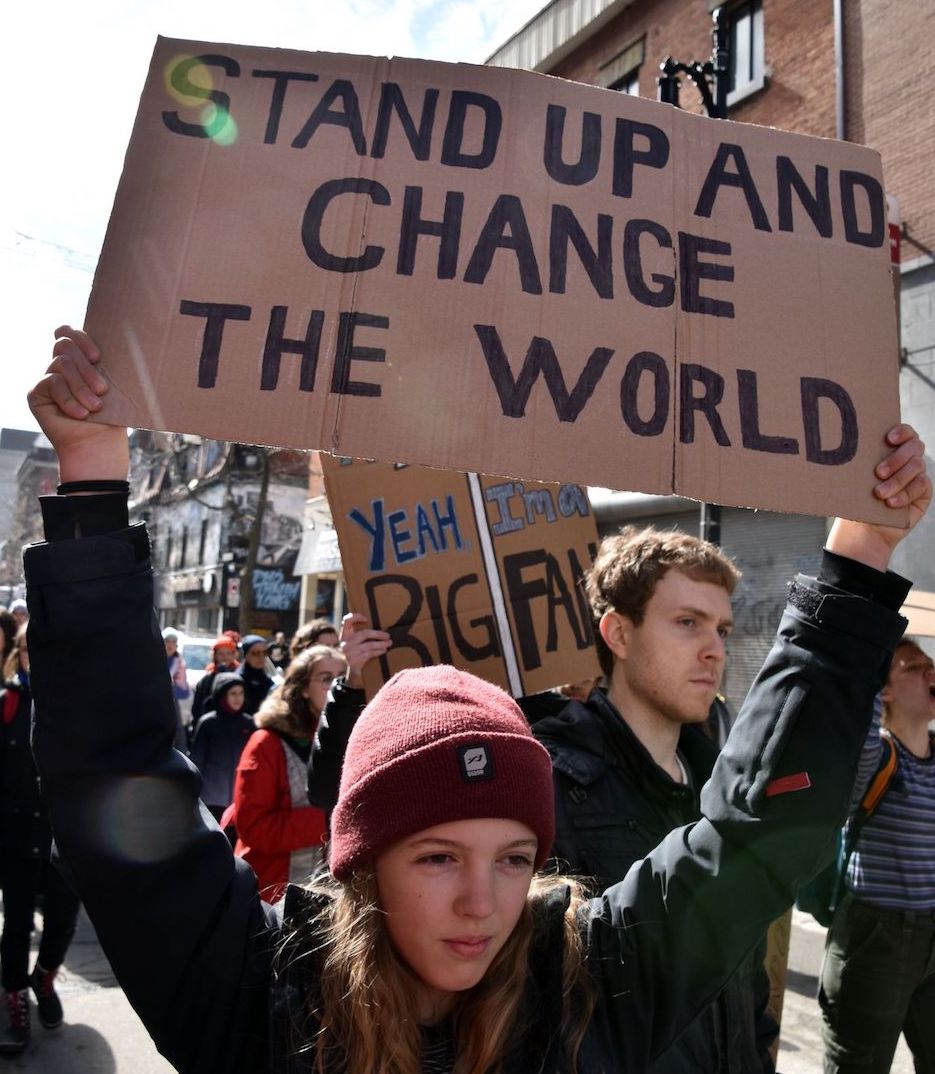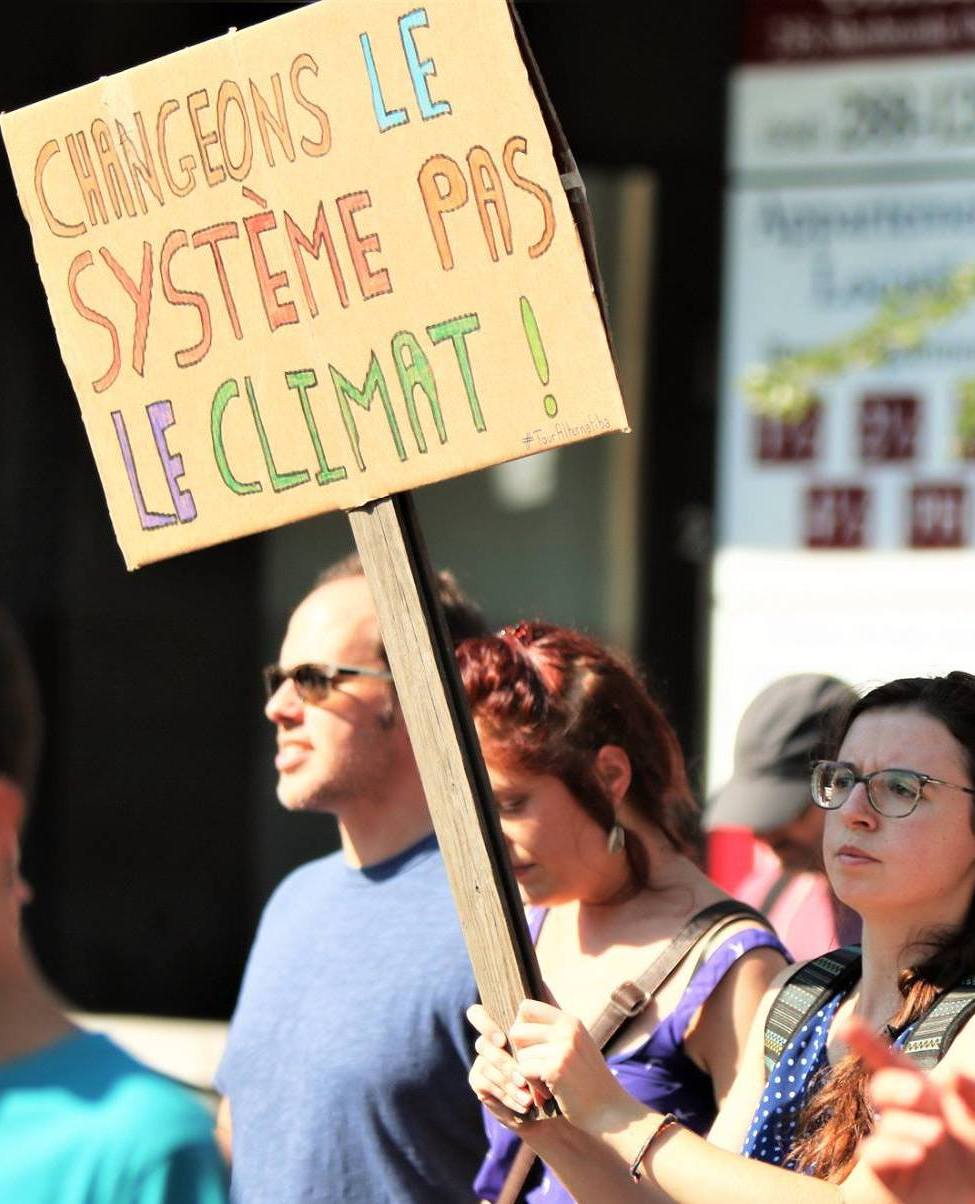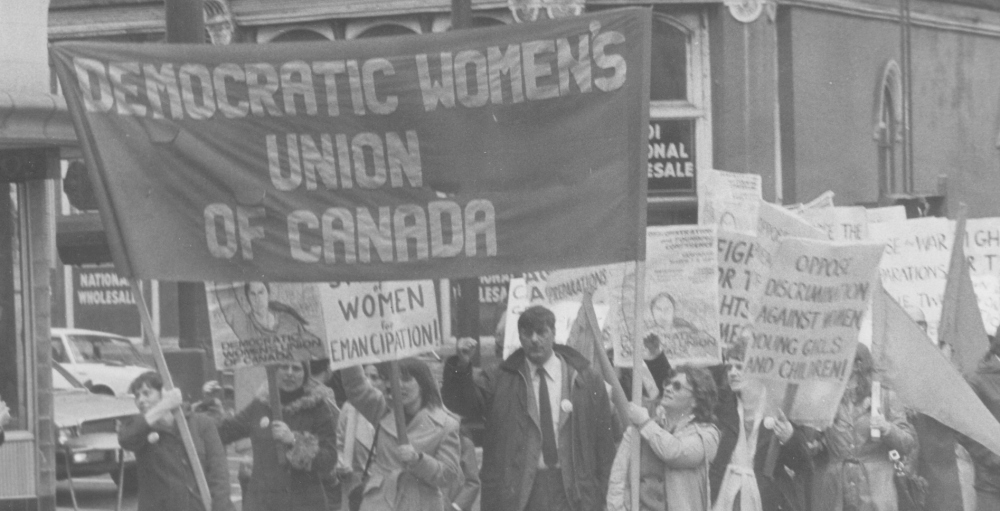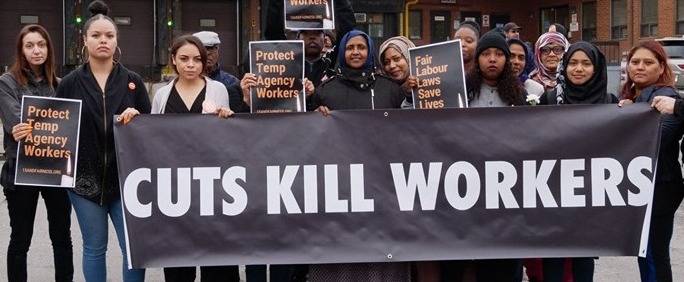
|
March 7, 2020 - No. 7 Women as Leaders in the Fight for the Rights of All Celebrate International Women's Day 2020
On
the Question of Women, the Hypocrisy of - Christine Dandenault -
Women, Children and Seniors Hardest Hit by Poverty Women and Children Increasingly Turned Away from Shelters Labour Statistics and the Gender Gap
Federal
Government Cannot Escape Its - Barbara Biley -
The Vibrant Legacy Inherited by CPC(M-L) Women
in the Front Ranks of the Fight Women as Leaders in the Fight for the Rights of All Celebrate International Women's Day |
|
On the Question of Women, the Hypocrisy of
Liberal Government Knows No Bounds

International Women's Day 2019, Montreal
Status of Women Canada announced on February 24 that the theme it has chosen for International Women's Day 2020 is #BecauseOfYou. Given that women in every walk of life across the country are shown disrespect every day because of the pay-the-rich agenda of governments at all levels, no matter what the government says on this occasion, it is hypocritical and offensive.
Status of Women Canada explains the theme in these words: "Empowering women and girls to equally participate in economic, social and political life benefits people of all genders. It increases economic prosperity, promotes peace and security, upholds fairness and justice in our society, and ultimately creates happier and healthier communities." Who is Status of Women talking to? The teachers and education workers who are fighting, coast to coast? Civil servants who face cutbacks to services, which affect women the most? Nurses and health professionals whose conditions of work make it impossible to deliver the health services they are pledged to provide? Is Status of Women Canada speaking to the Indigenous mothers, sisters, aunts and grandmothers who face colonial injustice and abuse every day of their lives? Is it addressing migrant and national minority women whose rights are trampled underfoot as a matter of course?
Women are invited
to listen to the personal experiences of the
women promoted by Status of Women Canada as
examples they should emulate, as if it is the
fault of women if they are not "successful." One
claim, amongst others, is that employing more
women increases Canada's gross domestic product!
It is not just condescending and seeking to
justify the wretched conditions under which women
are employed, but it tries to divert attention
from the main problem facing the entire Canadian
working class, which is that the working people
exercise no control over the direction of the
economy or their conditions of employment.
Through sleight of hand, Status of Women Canada denies the Canadian government's responsibility to recognize and guarantee the rights of women, including that they be paid the same wages as their male counterparts for the same jobs. It denies that the conditions of women are worsening in all aspects of life as a result of the ruling elite's anti-social offensive, in particular with the increasing precariousness of working conditions and poverty, as well as the violence committed against women, including abuse of the elderly.
In addition to denying the conditions of women and the reality of the anti-social offensive, Status of Women Canada speaks of the "benefit" of "equal participation in economic, social and political life." It provides as a reference point and goal the same current political system and process which deprives the people of power and increasingly relies on the police powers of the state to impose the dictate of the financial oligarchy and criminalize the people's struggle for their rights. It is precisely against this very system and process that women teachers, education workers, health care workers, public servants and Indigenous women are courageously fighting this March 8. They are at the forefront of the struggle to empower themselves and empower the people to provide a new direction to the economy and political affairs.
In the absence of a guarantee of women's rights and with the political status quo as an objective, the prosperity, peace and security invoked by Status of Women Canada cannot be anything other than the prosperity of the tiny ruling elite that controls the economy, with their warmongering and criminalization of the peoples' struggles.
The prosperity of the financial oligarchy requires that women be employed at low wages, in precarious conditions, on call, without security; it requires trafficking in human beings and the exploitation of migrant women, both as women and as migrants. In terms of peace and security, the government is intent on rallying women behind the warmongering of the U.S., with Canada playing the role of appeaser, carrying out its own activities of interference, dirty manoeuvring and aggression in Venezuela, Haiti, and elsewhere to maintain U.S. imperialist domination and suppress any nation-building project that is for the well-being of the people and controlled by them.
There is no doubt that in its "#BecauseOfYou" theme, Status of Women Canada has in mind women such as Chrystia Freeland, who participates very well as an equal in the political life because she is a champion in her own right of U.S. imperialist domination and regime change through the organization of coups against the peoples of Venezuela, Bolivia and other countries. As far as fairness and justice are concerned, it is clear that those who use such language amongst the ruling elite have never had to live on $700 a month, have never experienced hunger or poverty or had to use food banks.
"#BecauseOfYou" has nothing to do with women. The struggle of women for their emancipation is a collective struggle to humanize the natural and social environment by laying the claims which belong to everyone by virtue of being human. Through their actions, women are making themselves heard, and taking collective decisions that advance their cause on all matters of concern to them. This is how they are dealing with the problems of the present. Their actions in the here and now inform the future that we want to bequeath to our children.
Facts and Figures on Conditions of Women in Canada
Women, Children and Seniors
Hardest Hit by Poverty
 Statistics Canada
reported on February 24, that based on the market
basket measure, around 3.2 million Canadians, or
8.7 per cent of the population, were living below
Canada's Official Poverty Line in 2018.[1] For those under
18 years of age, the poverty rate was 8.2 per
cent, or around 566,000 children.
Statistics Canada
reported on February 24, that based on the market
basket measure, around 3.2 million Canadians, or
8.7 per cent of the population, were living below
Canada's Official Poverty Line in 2018.[1] For those under
18 years of age, the poverty rate was 8.2 per
cent, or around 566,000 children.
For those living in couple families, the child poverty rate was 5.8 per cent, compared with 26.2 per cent for those in female lone-parent families. In other words, children living in single parent families headed by women are almost three times more likely to be living in poverty than those living in couple families.
Around 216,000 persons aged 65 years and older, or 3.5 per cent of the senior population, lived in poverty in 2018, with 1.7 per cent of seniors who lived with families living in poverty compared to 7.9 per cent of unattached seniors, which is over six times higher.
The overall low-income rate based on the low-income measure was 12.3 per cent in 2018 for children and 14.3 per cent for seniors.[2]
A 2018 Angus Reid study indicated that women are more likely than men to experience poverty. The study looked at Canadians' self-reported experiences of financial hardships. It suggests that 16 per cent of Canadians could be categorized as "struggling" economically. This means that they face ongoing difficulty covering expenses for basics, including food, utilities, winter clothing, housing, and dental care, and may have to use services such as "pay day loans" and food banks to get by. Sixty per cent of those in the "struggling" category are women, while 40 per cent are men.
Some groups of women have higher rates of poverty and are more likely than others to be poor. The prevalence of low incomes among the following groups of women and girls is particularly high:
- Aboriginal women and
girls with registered or Indian treaty status --
32.3 per cent
- First Nations women and girls -- 34.3 per cent
- Mιtis women and girls -- 21.8 per cent
- Inuit women and girls -- 28 per cent
- Women with disabilities -- 23 per cent (based on
2014 data)
- Immigrant women (those who immigrated to Canada
between 2011 and May 10, 2016) -- 31.4 per cent
- Single mothers and their children -- 30.4 per
cent
- Children (age 0 to 17) living with single
mothers -- 42 per cent (compared to 25.5 per cent
of children in male lone-parent families and 11
per cent in two-parent families)
- Senior women aged 65 and up -- 16.3 per cent
(based on 2015 data)
 In some parts of
the country, there are appallingly high rates of
poverty. For instance, 50 per cent of status First
Nations children in Canada live in poverty; that
figure increases to 64 per cent in Saskatchewan
and 62 per cent in Manitoba.
In some parts of
the country, there are appallingly high rates of
poverty. For instance, 50 per cent of status First
Nations children in Canada live in poverty; that
figure increases to 64 per cent in Saskatchewan
and 62 per cent in Manitoba.
More than 235,000 Canadians experience homelessness annually. On a given night, more than 35,000 Canadians are homeless. Women parenting on their own enter shelters at twice the rate of two-parent families. Domestic violence against women and children is a contributing factor to homelessness. When women become homeless, they are also at an increased risk of violence, sexual assault and exploitation.
Over 25 years, child and family poverty has increased by 25 per cent, rising from 15.8 per cent of children in 1989 to 19.1 per cent of children in 2012.
How Does Canada Compare?
In March 2019, the Organization for Economic Co-operation and Development (OECD) reported that Canada's relative poverty rate of 12.4 per cent was "slightly above" the average for OECD member countries, at 11.7 per cent. While poverty rates for the elderly population were lower than average compared to other OECD countries, the poverty rates for children and youth in Canada were higher than the OECD average.
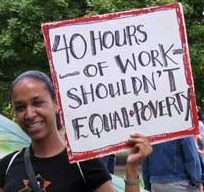 The OECD also
reported that Canada ranks in the top five of OECD
countries that have the highest shares of
households owning their property with a mortgage
(41 per cent of all households). It noted that the
housing cost burden is particularly onerous for
low-income people -- 48 per cent of low-income
owners with a mortgage spent over 40 per cent of
their disposable income on a mortgage in 2016, the
fifth highest share among OECD countries, and that
the same indicator decreases to 43 per cent for
low-income renters.
The OECD also
reported that Canada ranks in the top five of OECD
countries that have the highest shares of
households owning their property with a mortgage
(41 per cent of all households). It noted that the
housing cost burden is particularly onerous for
low-income people -- 48 per cent of low-income
owners with a mortgage spent over 40 per cent of
their disposable income on a mortgage in 2016, the
fifth highest share among OECD countries, and that
the same indicator decreases to 43 per cent for
low-income renters.
As for safety concerns, the OECD noted that only 7 per cent of Canadian men did not feel safe walking alone at night in the city or area where they lived in 2016/17. The share of Canadian women who feel unsafe is considerably higher, at 27 per cent, but still lower than for many OECD countries, where 32 per cent of women do not feel safe on average.
Notes
1. According to the market basket measure, a family lives in poverty if it does not have enough income to purchase a specific basket of goods and services in its community.
2. According to the low-income measure, individuals live in low income if their household after-tax income falls below half of the median after-tax income, adjusting for household size. The median after-tax income of Canadian families and unattached individuals was $61,400 in 2018.
(Sources: Canadian Women's Foundation's Factsheet: Women and Poverty in Canada, Statistics Canada, OECD)
Women and Children Increasingly
Turned Away from Shelters
 A March 5 CBC news
item informs that in November 2019, an average of
620 women and children a day were turned away from
domestic violence shelters across Canada. In more
than 80 per cent of cases, people were turned away
because the shelter was full. The report
notes that the data is incomplete as it is based
on just over half of the 527 shelters CBC
contacted.
A March 5 CBC news
item informs that in November 2019, an average of
620 women and children a day were turned away from
domestic violence shelters across Canada. In more
than 80 per cent of cases, people were turned away
because the shelter was full. The report
notes that the data is incomplete as it is based
on just over half of the 527 shelters CBC
contacted.
Not only is the number of people turned away each day in the hundreds, it is growing. Statistics Canada figures show the number increased 69 per cent from 539 in 2014 to 911 in 2018, based on data from all of the shelters in the country.
The same news source also notes that domestic violence shelters are forced to turn women and children away in significant numbers in all of Canada's major cities.
A lack of affordable housing puts rents out of reach for many of the women who use the shelters and keeps some living with their abusers.
Even when women are able to get into emergency shelters, their stay is often limited to between one and three months.
(Source: "Women, children turned away from shelters in Canada almost 19,000 times a month," by Tara Carman, CBC News, March 5, 2020.)
Labour Statistics and the Gender Gap
- In 2018, female employees aged 25 to 54 earned $4.13 (or 13.3 per cent) less per hour, on average, than their male counterparts. In other words, these women earned $0.87 for every dollar earned by men.
The Gender Wage Gap Decreased Between 1998 and 2018
- The gender gap in hourly wages has narrowed by $1.04 (or 5.5 percentage points) since 1998, when it was $5.17 (or 18.8 per cent).
The reduction in the gender wage gap between 1998 and 2018 was largely explained by changes in the distribution of men and women across occupations; women's increased educational attainment; and the decline in the share of men in unionized employment.
- The two largest factors explaining the remaining gender wage gap in 2018 were the distribution of women and men across industries, and women's overrepresentation in part-time work, the same largest explanatory factors behind the gap in 1998.
Real wages (adjusted for inflation) grew faster for women aged 25 to 54 than for men in this age group between 1998 and 2018 (Table 1). Specifically, women's average real hourly wages increased by 20.5 per cent over the period, while men's increased by 12.9 per cent. As a result, the gender wage gap decreased by 5.5 percentage points, from 18.8 per cent in 1998 to 13.3 in 2018.
Change in Occupational Distribution a Key Contributor
Between 1998 and 2018, the occupational distribution of men and women explained just over a quarter (26.3 per cent) of the reduction in the gender wage gap. Notable narrowing effects came from professional occupations in law and social, community and government services (8.5 per cent), professional occupations in education services (7.7 per cent) and professional occupations in business and finance (7.2 per cent). These three higher-paying occupational groups employed a larger share of core-aged women in 2018 than in 1998. Also, earnings grew faster for women than men in two of the three groups (professional occupations in law and social, community and government services and professional occupations in business and finance).
Despite the net positive effect of occupation on the narrowing of the gender wage gap, some individual occupations served to widen the gap, notably professional occupations in natural and applied sciences (-9.2 per cent) and administrative and financial supervisors and administrative occupations (-7.4 per cent). These two groups employed a larger share of core-aged men in 2018 than in 1998, while earnings also increased faster for men than women in professional occupations in natural and applied sciences.
Changes in Industrial Distribution Decrease Gender Wage Gap
Although changes in occupational distribution contributed to the decrease in the gender wage gap from 1998 to 2018, the distribution of men and women across industries served to widen the gap (-8.0 per cent). This was driven by the high-paying and male-dominated construction sector (-14.0 per cent), where employment increased over the period. The manufacturing sector helped to counteract the effect of construction, contributing 7.3 per cent to the narrowing of the gap over the 20 years. This was largely due to the decline in employment in manufacturing that occurred over the period, with 25.2 per cent of core-aged men employed in this sector in 1998, compared with 15.5 per cent in 2018.
Women's Increased Educational Attainment Helped to Narrow Gap
The increase in women's educational attainment, relative to men's, was the second most important determinant of the decrease in the gender wage gap between 1998 and 2018. While equivalent proportions of women and men had a university degree at the bachelor level or above in 1998 (21.6 and 21.5 per cent, respectively), the proportion of women with at least a bachelor's degree increased to a greater extent in the following 20 years than did the equivalent proportion of men (+19.6 percentage points vs. +10.8 percentage points). As workers with higher education earned more on average, the relative increase in women's educational attainment accounted for 12.7 per cent of the decrease in the gender wage gap that occurred over the period.
The other human capital variable, job tenure, explained 5.5 per cent of the reduction in the gap, largely due to a decline in men's job tenure relative to women's between 1998 and 2018. By 2018, women's average job tenure (89.4 months) surpassed that of men (86.8 months).
Men's Decreased Union Coverage Also Had Narrowing Effect
Changes in job attributes also contributed to the decrease in the gender wage gap that occurred over the 20 years. Particularly important in this regard was union coverage. While the proportion of men covered by a union or collective agreement decreased by 8.6 percentage points between 1998 and 2018 (from 38.2 to 29.5 per cent), the equivalent proportion for women held steady at a little less than 36 per cent. These differing trends largely reflected the fact that men with union coverage were concentrated in manufacturing -- a declining sector through the first half of the period -- whereas women in unionized jobs have been concentrated in health care and social assistance, and educational services. Since union coverage is associated with higher average wages, the decrease in the proportion of men with union coverage led this variable to account for 9.3 per cent of the decrease in the gender wage gap that occurred between 1998 and 2018.
The other job attribute variables each accounted for a smaller part of the narrowing over the period, with part-time and public sector employment at 4.8 per cent each, and firm size at 3.1 per cent. Beginning with part-time employment, the narrowing effect was tied to a decline in the proportion of women working part time, from 21.0 per cent in 1998 to 16.0 per cent in 2018. Meanwhile, the narrowing explained by public sector employment was due to an increase in the proportion of women working in the public sector (34.1 per cent in 2018, compared with 31.1 per cent in 1998), while earnings returns for these workers also increased. Lastly, the portion of the narrowing explained by firm size was driven by an increase in the proportion of women working for large firms (defined as having more than 500 workers), which tend to have higher wage premiums than smaller firms.
Key Part of Remaining Gap Explained by Industrial Distribution
The industrial distribution of men and women explained the largest portion of the gender wage gap in both 1998 (16.5 per cent) and 2018 (39.7 per cent). Additionally, the same three sectors drove the gender wage gap in both years: construction (6.3 per cent in 1998 and 17.7 per cent in 2018), manufacturing (8.5 per cent in 1998 and 9.1 per cent in 2018), and mining, quarrying, and oil and gas extraction (3.5 per cent in 1998 and 6.7 per cent in 2018). These three sectors drove the gender wage gap in both 1998 and 2018 due to employing substantially larger shares of men than women, and due to their relative wage premiums.
Along with industry, occupational distribution also explained a small part of the gap in 1998 (1.8 per cent) and 2018 (5.1 per cent). Among all occupations, the male-dominated professional occupations in natural and applied sciences contributed the most to the existence of the wage gap in both 1998 and 2018. This is consistent with the results discussed above, showing that increased employment and earnings for men in this occupational group had a widening effect on the gap over time.
Part-time Employment Contributes to the Gap
Beyond gender differences in industry and occupation, only women's overrepresentation in part-time employment explained a notable portion of the gap in 1998 (8.9 per cent) and 2018 (9.2 per cent). While the previous section showed that some reduction in part-time work among women contributed to the narrowing of the gap over the period, and even though women received a smaller wage penalty for part-time work than men, women's higher likelihood of working part time still contributed to the existence of a gender wage gap in both 1998 and 2018.
Despite having virtually no effect in 1998, public sector employment and union status each counteracted the gap in 2018, at -5.3 and -3.4 per cent respectively. This is consistent with the previously-discussed increase in public sector employment for women and decrease in union coverage among men between 1998 and 2018.
While job tenure had little impact on the gap in 2018, men's longer job tenure than women in 1998 explained a small portion of the gap (2.3 per cent) at that time. Education had virtually no impact on the gap in 1998, but it counteracted it in 2018 (-4.8 per cent). This finding largely reflects the fact that more women than men had a university degree at the bachelor level or above in 2018.
(Source: "The gender wage gap in Canada: 1998 to 2018," Rachelle Pelletier, Martha Patterson and Melissa Moyser, Statistics Canada, October 7, 2019.)
Uphold Indigenous Hereditary Rights -- Stand with Wet'suwet'en
Federal Government Cannot Escape Its Responsibility to Indigenous Peoples

Indigenous Youth for Wet'suwet'en set up
ceremonial space on the BC legislature lawn,
March 4, 2020 and call on the premier and BC
government to be accountable and come out
and meet with them. (T. Coste)
There is much speculation about the contents of an agreement reached between representatives of the federal and provincial governments and Wet'suwet'en hereditary chiefs and others when they met in Smithers in northern BC, from February 27 to March 1. Former NDP MP Nathan Cullen was hired by the BC government to facilitate the talks. Reports indicate that the meetings resulted in an arrangement between the Wet'suwet'en and the federal and provincial governments with regard to the recognition of hereditary rights and title. The Wet'suwet'en will not release details of the agreement pending discussion within the Wet'suwet'en nation, which is to take place soon.
Reports indicate that the agreement did not deal with the outstanding issue of the Coastal GasLink Pipeline, which does not have the consent of the hereditary chiefs for construction and operation on the territory for which they are responsible.
Since early January, the hereditary chiefs had been asking Prime Minister Trudeau and BC Premier Horgan to meet with them, as equals, on the basis of nation-to-nation relations, a request which has been repeatedly denied by the prime minister and the premier. One of the youth who spoke at a press conference at the BC Legislature on February 26 nailed the explanation. She said "There's a reason why John Horgan and Trudeau won't meet with these chiefs, because as soon as they meet with these chiefs they affirm that they are the leaders and the rightful owners of their own territories. We all know that economically it doesn't make sense for Trudeau and Horgan to not meet with these chiefs and so we have to ask ourselves 'Why is that?' And the root of this issue is that they don't want to give our people the recognition that we own our own territories, because every other project that they are going to try to push through our lands, we'll be able to say no to."
Trudeau, with solidarity actions and disruption across the country continuing, keeps insisting that his government wants a "peaceful and lasting solution," but fails to recognize the root cause of the problem which he claims to want to solve. When asked in the House of Commons on February 26 by NDP leader Jagmeet Singh whether he would commit to meet with the Wet'suwet'en hereditary chiefs, Trudeau put the blame for the current situation on the Wet'suwet'en. He said, "I explained that there were many voices within the Wet'suwet'en community: some hereditary chiefs, some elected chiefs and some leaders within the community as well. The work they need to do, without outside interference, to determine their path forward would be interfered with by a prime minister sitting down with one group too quickly. I am of course open to engaging constructively, but in the right way."
Trudeau's suggestion that the problems exist because the Wet'suwet'en are divided and they need to get their own act together, ignores the crucial issue that the federal government created a so-called third level of elected government to keep the decision-making power out of the hands of the people. Those it calls elected representatives represent the Crown, not the people. Their role is to make sure the people put up and shut up and it is all done in the name of democracy. As for business leaders and leaders of other special interests, nobody ever chose them to be spokespersons for the people. The two systems of governance -- the hereditary law on the unceded territory and the elected band councils imposed by the Indian Act on reserves -- are not compatible because the former is not recognized and the latter is an integral part of the dispossession of the Indigenous peoples, which needs to be scrapped altogether because it is part of the colonial legacy.
As for differences of opinion, they exist throughout Canadian society on issues related to resource development and how to maintain and humanize the natural and social environment. So long as governments at different levels will not permit discussion to take place in such a manner that the people can explore their options from their perspective and by establishing their reference points, these differences cannot be sorted out and the people are set at loggerheads even though they all want the same thing -- livelihoods, sustainable development, a healthy natural and social environment. Instead of actually permitting discussion and permitting the people to formulate warranted conclusions, the government of British Columbia is pushing through the Coastal GasLink pipeline in spite of the fact that the Wet'suwet'en hereditary chiefs have not consented to the pipeline route through the territory for which they are responsible. The provincial government has issued the permits for Coastal GasLink in spite of the company not having that consent. It has enforced that decision by means of a militarized RCMP occupying force which unlawfully harasses and interferes with the people who live and work on the territory and have twice violently assaulted and removed Wet'suwet'en people from their own land. It is the height of arrogance to suggest that "the problem" is "divisions within the Wet'suwet'en" and that Trudeau, as the leader of the Canadian government, is helping the situation by "not sitting down with one group too quickly."
When Prime Minister Trudeau and Premier Horgan speak of reconciliation they mean that Indigenous peoples should reconcile themselves to the unfettered access to their land by the resource companies with the federal and provincial governments as their agents and the RCMP as the enforcer. As long as this is the outlook that they bring to the table, the fundamental issues will not be addressed and the fight of Indigenous peoples to affirm their rights will persist.
The agreement reached in Smithers has kindled hope that the federal government and the province have recognized the hereditary rights of the Wet'suwet'en, 23 years after the Supreme Court decision in Delgamuukw, which called on the provinces and the federal government to reach a political settlement on the historical denial of the hereditary rights of Indigenous peoples. Whether or not the agreement reached in Smithers will be endorsed by the Wet'suwet'en, the problem remains of the immediate issue of the Coastal GasLink Pipeline. Work had been suspended by Coastal GasLink while the talks were taking place but restarted on March 2 although the hereditary chiefs and the land defenders at the Unist'ot'en Camp continue to declare their opposition. The RCMP, which stood down during the talks, has also recommenced patrols on Wet'suwet'en territory.
The rail blockades in Ontario and Quebec came
down in the last week but actions in support of
Wet'suwet'en claims, including student walkouts
across the country on March 4, continue. In one
action hundreds of students joined the Indigenous
youth who have occupied the steps of the BC
Legislature to show their support for the just
stand of the Wet'suwet'en land defenders.
March 4 National Student Walkout
in Solidarity with Wet'suwet'en

University of British Columbia, Vancouver
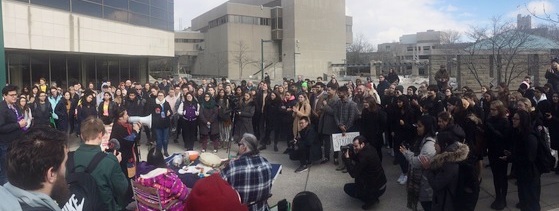
Simon Fraser University, Burnaby

Winnipeg
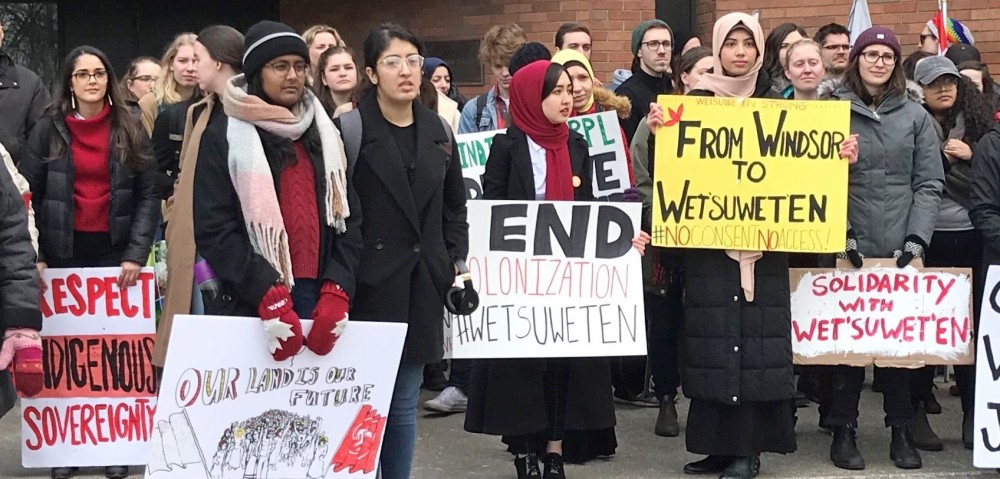

University of Windsor

University of Western Ontario, London


Guelph

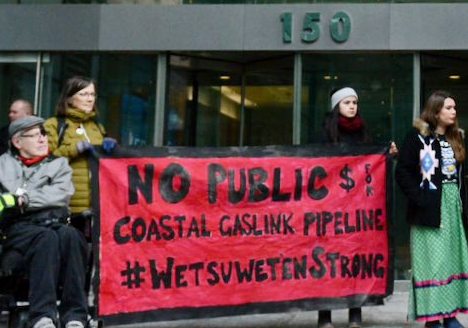
Ottawa

Halifax
(Photos: TML, A. Crawshaw, T. Smith, K. Rae, GeekbyGek, UBC 350, aahaasuwiimiikwan, I. Nova.)
Celebrate 57th Anniversary of Founding of The Internationalists
The Vibrant Legacy Inherited by CPC(M-L)
Under the leadership of Hardial Bains, The Internationalists was founded at the University of British Columbia on March 13, 1963. The uninterrupted advance of The Internationalists led to the founding of the Communist Party of Canada (Marxist-Leninist) in Montreal on March 31, 1970. The achievements of The Internationalists in preparing the subjective conditions for CPC(M-L) became the legacy inherited by the Party and remains so to this day.
The Internationalists has significance in the life of the Party today because its positions and program were based on the actual conditions of the country. The organization worked out theory in the course of the struggle to change those conditions. The Internationalists relied on the working class to set the aim to resolve the crisis in its favour in every period so as to open society's path to progress. Any deviation or opposition to the fundamental positions would have led to the destruction of The Internationalists and to CPC(M-L) as well.
|
Militant defence of its independence and to think for itself are important legacies CPC(M-L) inherited from The Internationalists. The insistence of the Party to think for itself in opening the path for its work and not to depend on or bow down to this or that analysis from any other quarter ensured that both The Internationalists and CPC(M-L) could pass through extremely complicated periods successfully without compromising their principles and fundamental positions or merging with the fad of the day.
|
|
During the sixties, one fad was to pick up this or that idea and turn it into a document and seek unity on that basis. Another one was to blindly follow the Soviet Union and other countries without carrying out an independent analysis of the conditions of the country in which the Party was operating and thinking for itself. The necessity was and continues to be to this day for Parties to examine other countries from an angle that can advance the movement of the working class and allies in the country where they are operating and the workers of all lands. No struggle could be successful if based on the Soviet Union, the People's Republic of China, Yugoslavia or any other country and not on a concrete analysis of Canada. Such an independent stand and thinking for itself stood the Party in good stead.
This can be seen at the present time. The legacy of militant defence of its independence and thinking for itself means the Party stands firmly on its own two feet and is capable of finding its bearings in the complicated circumstances that characterize this historical turning point in which old forms have passed away and new forms have yet to be brought into being.
Those who live off the thinking of others and succumb to the official state disinformation can provide nothing vibrant nor inspire the working people to march on and build the New. Sooner or later those who mouth what they hear from the old forces collapse. Such is the case of those who eke out a living repeating phrases, refuse to analyze the unfolding events and fail to implement the Party's positions, line and guides to action in a living way.
50th Anniversary of CPC(M-L)
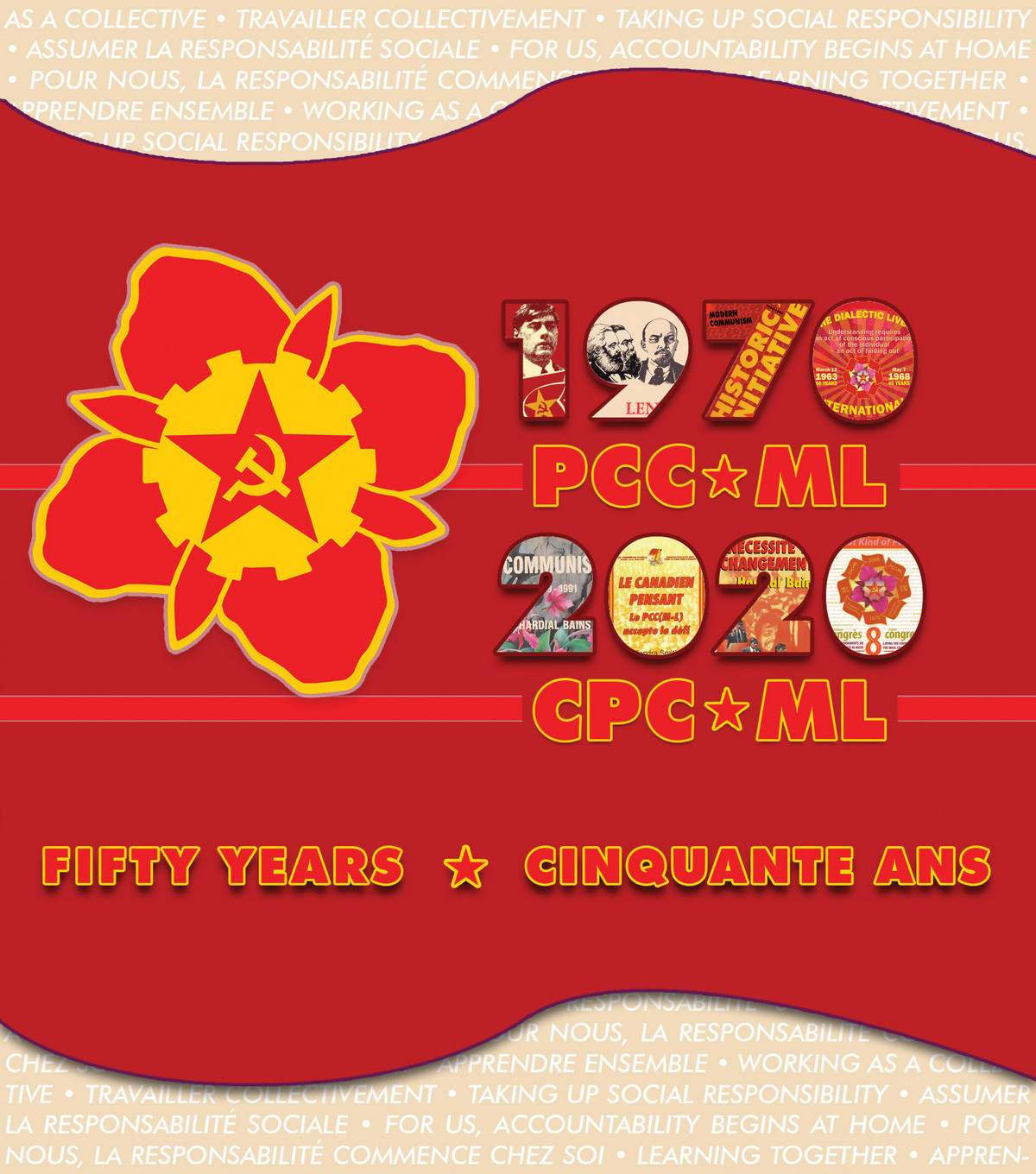 CPC(M-L) is
celebrating the 57th anniversary of the founding
of The Internationalists within the
context of the coming celebration of the 50th
anniversary of its own founding. The Party has its
program for renewal at this time to ensure it
remains consistent with the concrete conditions of
today. The Party inherited this quality from The
Internationalists, to always base its
political action on its own analysis of the
national and international situation without
succumbing to the lure of an idea. This quality
can be found in the fullness of the analysis of
the present period found in the pages of TML
Weekly and Workers' Forum and its
political action program to Stop Paying the Rich;
Increase Investments in Social Programs!
CPC(M-L) is
celebrating the 57th anniversary of the founding
of The Internationalists within the
context of the coming celebration of the 50th
anniversary of its own founding. The Party has its
program for renewal at this time to ensure it
remains consistent with the concrete conditions of
today. The Party inherited this quality from The
Internationalists, to always base its
political action on its own analysis of the
national and international situation without
succumbing to the lure of an idea. This quality
can be found in the fullness of the analysis of
the present period found in the pages of TML
Weekly and Workers' Forum and its
political action program to Stop Paying the Rich;
Increase Investments in Social Programs!
As the conditions have changed, so have the analyses and political programs, while the theory known as Contemporary Marxist-Leninist Thought that The Internationalists began to work out in its day has become all the more powerful. The role played by theory can be seen in the work in different spheres. The Internationalists and the Party have been able to use the organizing and mobilizing power of Contemporary Marxist-Leninist Thought, which has developed as work on the theoretical front has gained experience and expertise over the past 57 years. Theory develops as it illuminates a path forward for the ongoing work based on the conclusions drawn from the unfolding new experience gained here in Canada and by the international working class in all spheres of work.
The working class is the class of the here and now and the future. Its work is to lead the struggle to emancipate the working class and to create a new society without exploitation of persons by persons. The dogmatism and phrase-mongering of the obsolete classes and parties that call themselves democratic but form a reactionary cartel to keep the people out of power, can be seen in their double-talk during elections and their promises to provide problems with solutions, which they never keep. They base themselves on the dogmatic false ideological belief that theirs is the ultimate system humans are capable of developing and the final form of democracy.
In hailing the work of The Internationalists, CPC(M-L) draws attention to some of its salient features. These were not worked out in a dogmatic fashion from ideas but according to the conditions and analysis of the times as they developed, and by taking into consideration conclusions that have been added to theory. By doing so, the practical politics and summing up of the work enriches the theory making it applicable to the contemporary conditions.
More than ever before, the practical politics, and not adherence to this or that "ism," are crucial to achieve a definite aim the people define. The concretization of a line of march takes place only in the course of political work -- the practical politics -- which refers to the work to vest the sovereign decision-making power in the people whose representatives are not elected officials who toe a party line. Today, real political power is wielded through executive offices and police power, through a fictional person of state that rules over the majority of the people on behalf of the alien class interests of a minority.
CPC(M-L) greets the 57th anniversary of the founding of The Internationalists and all those members who participated in its work with the conviction that the striving of the working class and its allies to exercise control over the decisions affecting their lives will indeed affirm their desire for peace, freedom and democracy in the form of an anti-war government that brings forth and concretizes a totally new democratic personality. The working class will constitute the nation and vest sovereignty in the people with the aim of creating a society without the exploitation of persons by persons.
Long Live Our Party!
Long Live the Work of Its Founder Comrade Hardial
Bains!
(To access articles individually click on the black headline.)
Website: www.cpcml.ca Email: editor@cpcml.ca

